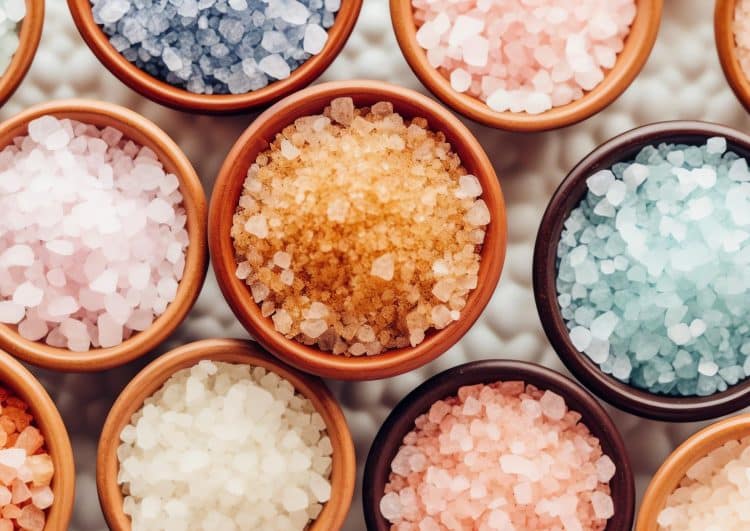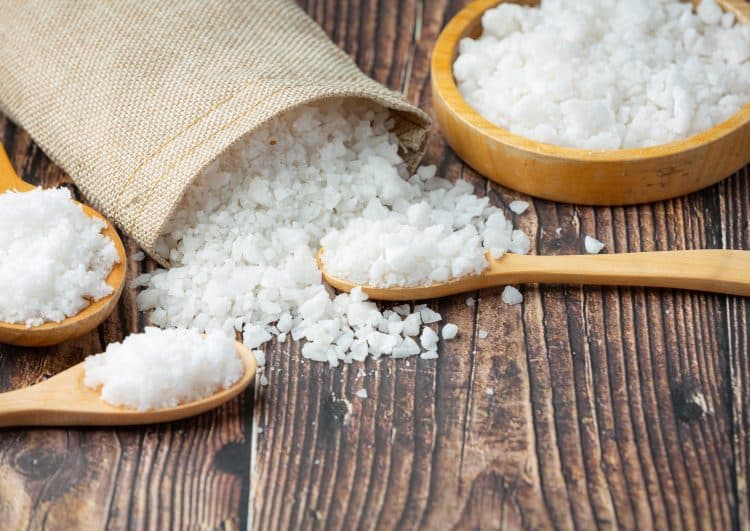Salting our food used to be simple. After all, it only came in one form — iodized table salt. Now, as many as a dozen varieties are available, each with different qualities. So, which is the healthiest?
In this article, I’ll reveal the ten healthiest salts as ranked by health experts. I’ll also explain what salt is, why it’s an essential part of a healthy diet, and how to ensure you’re not getting too much of it.
What is the Healthiest Salt?
Pink Himalayan salt tops our list of healthy salts.
Renowned as the most pristine and advantageous salt globally, pink Himalayan salt has been used for centuries by Himalayan residents for preserving meat and fish and for therapeutic purposes. It is extracted around 190 miles from the Himalayas in Pakistan, with deposits dating back over 4 billion years.
This salt originates approximately 5,000 miles below the earth’s surface. The mines undergo immense pressure, resulting in purportedly the purest salt with color variations — pink, white, or red.
Level Up Your Fitness: Join our 💪 strong community in Fitness Volt Newsletter. Get daily inspiration, expert-backed workouts, nutrition tips, the latest in strength sports, and the support you need to reach your goals. Subscribe for free!
So, what’s so good about pink Himalayan salt?
We’ve identified four key benefits:
1. Respiratory Enhancement
Because of its enhanced purity, pink Himalayan salt offers potent anti-inflammatory and anti-bacterial effects. Enhancing respiratory health, this method speeds up mucus’s expulsion and eradicates airborne pathogens.
Pink Himalayan salt is utilized in halotherapy, an ancient respiratory treatment. It helps to alleviate chronic bronchial issues. Additionally, it assists in sinus flushing and prevents eustachian tube blockages that may cause vertigo or tinnitus.
2. pH Balance
Maintaining an ideal pH level (7.3) is crucial for good health. The standard Western diet often causes acidity-related problems. Pink Himalayan salt is rich in electrolytes, helping to counteract excess acidity in the bloodstream. Combining it with a less acidic diet contributes to achieving optimal pH levels.
3. Digestive Enhancement
Pink Himalayan salt, used in a saturated solution called ‘sole,’ stimulates digestive peristalsis, balances stomach acid, regulates metabolism, and promotes digestive fluid production. Creating ‘sole’ involves mixing purified water with salt in a specific ratio for daily consumption, offering lasting digestive benefits.
4. Sleep Improvement
The 84 minerals in pink Himalayan salt make it a potent sleep aid. Studies reveal that low sodium levels can disrupt sleep, with participants on low-sodium diets experiencing reduced sleep and increased nighttime waking. Pink Himalayan salt, rich in minerals, effectively promotes better sleep patterns.
15 Key Minerals in Pink Himalayan Salt
Here is the list of 15 minerals in pink Himalayan salt:
| Mineral | Quantity (parts per million) | Mineral | Quantity (parts per million) |
| Sodium | 359,000 | Aluminum | 10.2 |
| Silicon | 244 | Calcium | 21.7 |
| Potassium | 4280 | Carbon | 37.2 |
| Sulfur | 481 | Fluoride | 12.9 |
| Magnesium | 23,900 | Iodine | 4.03 |
| Chloride | 579,000 | Rubidium | 8.78 |
| Bromine | 8.64 | Iron | 2.81 |
| Erbium | 1.72 |
9 Other Healthiest Salts
All salts can be beneficial when consumed in moderation. However, the purer the salt is, the more beneficial it will be. Here are the nine healthiest salts after pink Himalaya salt:
1. Sea Salt
Sea salt comes from evaporated seawater. Many prefer it to standard table salt because it has a higher mineral content and is more naturally sourced with minimal processing.
Sea salt contains the following vital minerals and trace elements:
- Magnesium
- Potassium
- Calcium
- Zinc
Sea salt has a distinctive flavor compared with table salt. It can improve the taste of a dish with a subtle richness that is uniquely its own.
It can enhance the taste of dishes with its salty notes and add a subtle richness to the overall flavor. The texture of sea salt ranges from fine to coarse. It is a versatile salt used in baking and cooking and as a finishing salt for sweet and savory dishes.
There is some iodine in sea salt, but less than in table salt. If you mainly use sea salt, you must ensure you get enough iodine from other sources.
2. Red Alaea Salt
Red Alaea salt is a sea salt that comes from Hawaii. Its distinctive red color is from a volcanic clay rich in minerals. It’s rich in such minerals as potassium, sodium, and iron.
The salt is naturally harvested from salt pans, requiring far less processing than table salt. As a result, it retains more of its mineral content.
Red Alaea salt is a favorite in traditional Hawaiian cooking, including poke and kalua pig dishes. It is also used in Hawaiian ceremonies and rituals.
3. Celtic Sea Salt
Celtic sea salt comes from the coast of Brittany in France. It is prized for its high mineral count and lack of processing. This type of salt is harvested using traditional methods such as wooden rakes. This helps to retain the salt’s coarse texture and high moisture content.
Celtic sea salt is milder than table salt. It is prized for its ability to balance out the body’s alkalinity to establish pH balance.
4. Black Lava Salt
Black lava sea salt is infused with activated charcoal. This gives the salt a black color. It shares the exact characteristics of sea salt with the added benefit of charcoal.
Activated charcoal binds toxins and chemicals in the digestive system. This helps to remove them from your system. It may also help to detoxify the body.
Some believe incorporating activated charcoal into salt can improve detoxification, although scientific evidence is limited.
Level Up Your Fitness: Join our 💪 strong community in Fitness Volt Newsletter. Get daily inspiration, expert-backed workouts, nutrition tips, the latest in strength sports, and the support you need to reach your goals. Subscribe for free!
Black lava sea salt preserves many minerals and trace elements in seawater, including magnesium and potassium. Thanks to the added charcoal, it has a distinctive, earthy, slightly smoky flavor.
5. Kosher Salt
Kosher salt, which is used to process kosher meat, comes from seawater or underground salt deposits. It is purified and ground, with the crystals being larger and coarser than table salt. They are also coarser and more irregular, making kosher salt easier to manipulate with the fingers.
Many chefs prefer kosher salt because it boosts natural flavor without adding a chemical taste. The large crystal size also means it contains less sodium than the same table salt volume.
6. Fleur de Sel
Fleur de Sel, which means flower of salt in French, is sourced from the top layer of salt pans, where it forms delicate crystals. It has a unique taste and texture that many chefs favor.
Fleur de Sel’s strong taste means you don’t have to use as much as other salts. It is also quite crunchy, adding a satisfying element to a meal.
Fleur de Sel contains trace elements of magnesium, potassium, and calcium.
7. Smoked Salt
Smoked salt is infused with a smoky flavor. This gives it a distinctive savory flavor that adds a unique taste to dishes. Smoked salt contains trace elements of calcium, magnesium, and potassium.
Smoked salt contains no additives or anti-caking agents and is minimally processed.
8. Bamboo Salt
Bamboo salt is sea salt packed in bamboo shoots, with the ends sealed with clay, then roasted. Minerals from the bamboo and clay are infused into the salt, increasing the overall mineral content.
Bamboo salt has alkaline properties that help balance the body’s pH. The clay and bamboo are also believed to increase the antioxidant properties of this sea salt. Antioxidants can neutralize free radical damage caused by oxidative stress.
9. Persona Blue Salt
Persian blue salt is derived from the Semnan province mines in Iran. Its unique blue color comes from silymarin, a natural crystal pigment. It’s valued for its visual appeal, unique taste, and health benefits.
This salt contains calcium, iron, magnesium, and potassium, though in relatively small amounts. It is minimally processed, containing no additives or anti-caking agents.
The flavor of Persian blue seat salt is mild and slightly sweet.
What is Salt?
Salt is a combination of sodium and chloride in equal amounts. It has the chemical formula NaCl. It is a natural preserver of foods and contains certain minerals and trace elements that the human body needs.
The most commonly used type of salt worldwide is table salt, refined to remove impurities. It often includes anti-caking agents. Iodine is often added to table salt to help offset the iodine deficiency that may cause thyroid problems.
Sodium, which makes up half of the salt content, is an essential mineral for humans. It is needed to balance fluid levels, support nerve function, and facilitate muscle contraction.
Too much sodium can cause health problems, including high blood pressure and cardiovascular disease.
The US Food and Drug Administration recommends not exceeding 2,300 mg of salt per day. However, the average intake in America is closer to 3340 mg. [1]
Benefits of Salt
Maintaining a proper balance of salt intake is crucial for optimized health. Here are five reasons to consume an adequate amount of salt:
Electrolyte Balance
Sodium is an essential electrolyte. It is needed for fluid balance within cells and tissues. Sodium is also required for muscle contraction and nerve function and to transmit electrical signals.
Nerve Function
Nerve impulses need sodium ions for their transmission. These impulses create signals that allow the brain to communicate with the different parts of the body.
Muscle Contraction
Sodium, potassium, and magnesium promote muscle contraction and relaxation. This makes it essential that serious weight trainers get an adequate salt supply.
Fluid Balance
Sodium helps balance intra and extra-cellular fluid levels. This balance helps maintain blood pressure, supports hydration, and promotes proper bodily functions.
Digestion
Sodium helps produce digestive juices in the stomach. These juices help break down foods.
Preservation of Food
Throughout history, salt has been used to preserve foods. It stops bacteria from growing on foods, preventing spoilage. Historically, salt has been so highly esteemed that it was often utilized as a means of payment. In fact, the word ‘salary’ is derived from the Latin ‘solarium,’ which refers to a payment made to Roman soldiers to buy salt.
How to Control Your Salt Intake
With most of us consuming about a third more salt than we should, there is a need for strategies to cut back. Here are five proven ways to reduce your sodium intake:
- Read Food Labels: Get into the habit of checking the sodium content of foods you buy. Look for low-sodium options that contain 140 mg per serving or less. If the label reads ‘reduced sodium,’ it contains at least 25% less sodium than the regular version of that food.
- Cook at Home: Cooking your own meals gives you total control over the amount of salt added. Experiment with different herbs, spices, and fresh ingredients to add flavor rather than rely on salt.
- Limit Processed Foods: Processed foods like canned soup and pre-packaged meals are notoriously high in salt. This is done to add flavor and preserve the food. Select whole foods as often as you can. When you do use canned foods, rinse the contents under water before use. This will reduce the sodium content.
- Drink Plenty of Water: Staying hydrated will help flush extra sodium from your body.
- Monitor Restaurant Meals: Restaurant meals can be dangerously high in sodium content. Ask for low salt options or request that sauces and dressings be served on the side so you can control the amount you add.
Conclusion
The healthiest salt on the planet is pink Himalaya salt. It will supply your body with essential minerals and electrolytes while boosting your respiratory system, improving digestion and sleep, and helping to balance your pH levels.
Use the suggested strategies to keep your salt intake to under 2,300 mg daily to ensure you’re reaping the rewards and avoiding the dangers of overconsumption.
References
- U.S. Food and Drug Administration. Sodium in Your Diet. FDA. [Updated February 25, 2022]. Available at: https://www.fda.gov/food/nutrition-education-resources-materials/sodium-your-diet. Accessed [12/26/2023].












Do any of the above salts clean and open up your blood flow arteries
pink salt has fluoride and aluminum? Fluoride is toxic and aluminum causes Alzheimers, dementia and autism spectrum disorders. Thats not healthy at all! Trying to get fluoride out of my water so I’m not ingesting it and absorbing it in my showers and handwashing. Don’t need it in my pink salt too.
Yes, pink salt can contain trace fluoride and aluminum, but at normal culinary use those amounts are tiny compared with established safety thresholds and typical daily exposures. If you would rather avoid them entirely, pick a lab-tested brand or use iodized table salt. You can check out this research-backed page for more information: https://ods.od.nih.gov/factsheets/Fluoride-HealthProfessional/